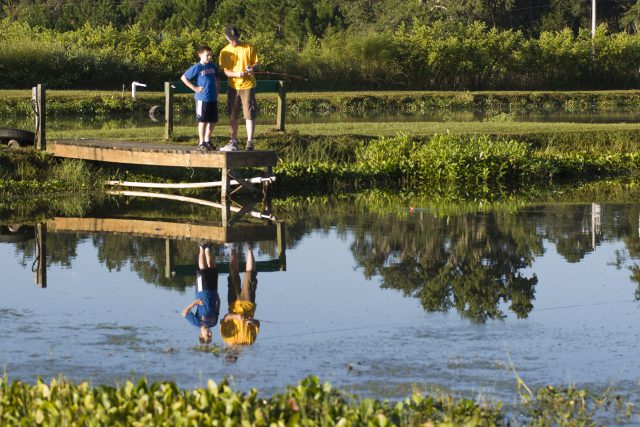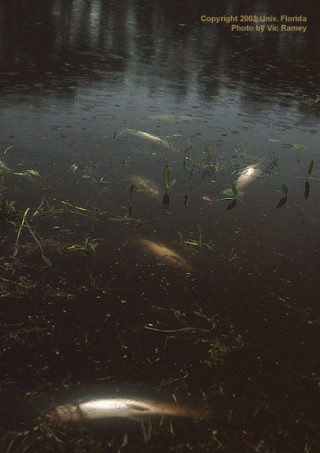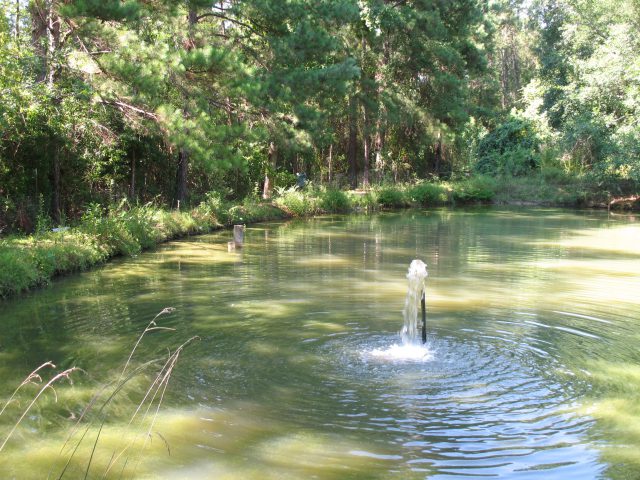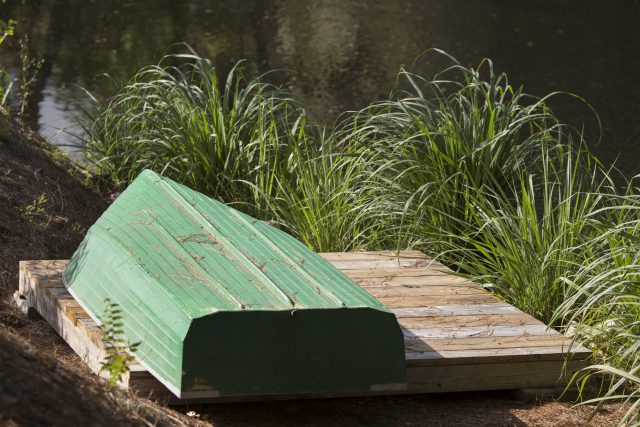
Farm ponds are used in a number of different ways, including fishing, irrigation, water control, and wildlife viewing. UF/IFAS Photo by Tyler Jones.
Farm ponds of all shapes and sizes are common in rural Northwest Florida. They are built for a number of reasons such as irrigation, water management, boating, fishing, wildlife viewing, livestock watering, and food production. Each of these uses guides the way the pond is managed to maintain its function, as well as its ecological beauty, but a factor that is important to all uses is having enough oxygen!
As you have probably observed, your pond is a dynamic system, which is influenced literally from the ground up! Much of the water’s basic chemical and physical characteristics reflect those of underlying soils (sand, clay, organic, etc.) and major sources of water (ground water, rainfall, runoff, etc.). The pond’s characteristics also influence how much oxygen is available for use by the plants and animals that live in it.
Why is Dissolved Oxygen and Aeration so Important?

Fish kills are often the result of low dissolved oxygen levels and occur in both natural waters and man-made ponds. Photo by Vic Ramey.
The idea of oxygen being dissolved in water is a little counter-intuitive. Especially to us, as air-breathing humans! Think of your pond as a giant living, breathing organism. Its atmosphere is the water itself, and it contains dissolved oxygen gas for the fish, aquatic plants, insects, and zooplankton to “breathe.” Even bacteria need to breathe, and one of their fundamental roles in your pond is the decomposition of organic wastes like un-eaten fish food, and dead plant and animal materials.
Having enough dissolved oxygen in the water is one of the driving forces sustaining the health of your pond. Oxygen is dissolved into water directly from the atmosphere, wind and wave action, and by plant photosynthesis. Because warm water “holds” less dissolved oxygen than cold water, your pond’s dissolved oxygen levels can be lower in the summer than in the winter, especially in the early morning hours before plants begin to photosynthesize and produce oxygen. While longer days and warmer temperatures mean more sunlight for plants to photosynthesize and produce oxygen, the demand or need for oxygen by fish, bacteria, and other aquatic organisms is also increased. Periods of rainy, overcast days during the summer can greatly reduce oxygen production by plant photosynthesis. Combined that with the increased oxygen demand by other organisms, and dissolved oxygen levels can drop fast. These drops in dissolved oxygen levels often result in fish kills. Productive, nutrient-rich ponds with high levels of organic materials, and a high fish density are at a greater risk of the devastating effects of low dissolved oxygen levels.
What Can You Do to Insure Your Pond Has Enough Oxygen?
Do not be tempted to overfeed your fish. Feed them floating fish food so you can see how much they will consume in 10 to 15 minutes at each feeding. Consider feeding them every other day. In addition, as recommended in Managing Florida Ponds for Fishing “do not feed them when the water temperature is below 60° F, or, above 95° F. Fish do not actively feed at these times.” Use fish feeding behavior as your guide. Uneaten food will only add excess organic matter to the pond. The decomposition of this excess organic matter by bacteria increases the oxygen demand and likewise increases the chances of low oxygen levels and a fish kill.
Reduce nutrient inputs from runoff, livestock waste, excess fertilizer, and uneaten foods as described above, to help reduce the demand for oxygen in the system. Excess nutrients from these sources are freely available for use by hungry algae and other plants, which can then proliferate and, in turn, cause demand for more oxygen. This increased demand for oxygen can cause fish kills due to low oxygen levels as described above.
If you have an aerator, keep it operative especially during extended periods of cloudy and rainy weather. Watch your fish for signs of oxygen stress (not eating, remaining near and gulping at the surface) and aerate accordingly. Oxygen levels naturally fluctuate, and the lowest levels occur in the late evening through early morning hours when plants are not photosynthesizing and replenishing oxygen. The most important time to routinely operate the aerator, therefore, is the late overnight hours into early morning.
If you don’t have an aerator, consider purchasing one, especially as your pond ages and grows more fish, plants, and algae. It is certainly less costly in the end to be proactive when it comes to maintaining adequate dissolved oxygen in your pond.
What kind of Aerator should I get?
There are a few basic aerator types. There are surface water agitators or fountains, and there are bottom air diffusers. They can be powered by electricity, wind, or solar power.
Diffuser aerators can help achieve a uniform oxygen distribution in your pond from top to bottom. This is especially important in deeper ponds (greater than 6-10 feet average depth) where temperature and oxygen stratification can occur. Diffuser aerators pump surface air through the base sitting on the bottom of the pond causing bubbles of air to rise to the surface. Diffusers also increase circulation and keep the deeper parts of your pond from becoming depleted of oxygen. In a new pond, or one with flocculent sediments, a diffuser may cause turbidity due to the physical action of the diffuser base sitting on the pond bottom circulating oxygen from the bottom to the surface.
Other aerator options are the fountain sprays or surface agitators that aerate surface water. At a bare minimum, this can be a hose shooting water out over the water surface. Surface fountains and agitators work well in small shallow ponds, but are generally not recommended for larger more productive ponds that need more oxygen. In some commercial or farm ponds, paddle wheel agitators powered by a tractor’s pto are used during periods of low oxygen as an emergency measure when a fish kill is just beginning to occur.
Where Can I Purchase One?
The type or types of aerators you need for your pond will depend on the pond’s size, depth, level of productivity (nutrient level, number of fish), use, and water quality. There are a number of shopping options online for pond aerators. Try searching using the term “pond aerators Florida.” Also, some local Panhandle fingerling fish farms sell these products too. Here is a list of fish farms from the Florida Fish and Wildlife Conservation Commission: FWC Freshwater Fish Stocking List. Additionally, there are dissolved oxygen meters you can purchase which accurately read the amount of oxygen in your ponds. This is yet another tool to use in the overall management of your pond.

Simple surface agitators can be used to aerate small shallow ponds, but are generally not recommended for larger more productive ponds that need more oxygen. Photo by Judy Biss
More information about pond management can be found in the following references used for this article:
Overview of Florida Waters – Dissolved Oxygen
Clemson Cooperative Extension: Aeration, Circulation, and Fountains
Southern Regional Aquaculture Center: Pond Aeration
Managing Florida Ponds for Fishing
The Role of Aeration in Pond Management
- Maintaining Dissolved Oxygen Levels in Your Pond to Reduce Fish Kills - September 21, 2018
- The Bumble Bee – One of Florida’s Vital Pollinators - September 14, 2018
- 2017-2018 Bee Informed Partnership’s National Bee Colony Loss Report - July 13, 2018

